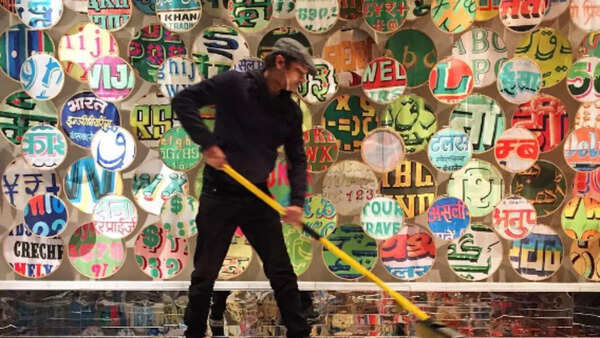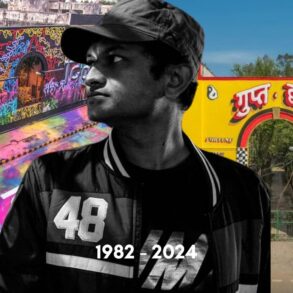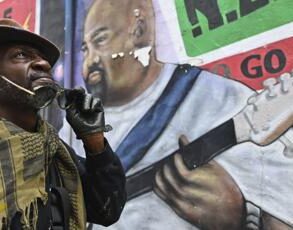Hanif Kureshi, the co-founder of the St+art India Foundation, and the man who revolutionised street art for Indians, unfortunately, passed away on Sunday, at the age of 41.
The world got to know of Hanif’s sudden demise through a post shared on St+Art India Foundation’s Instagram page, which read, “It is with deep sadness that we share the passing of Hanif Kureshi, our beloved Co-Founder, Artistic Director and artist.We are gutted and at a loss of words. Hanif was a gifted mentor, collaborator, friend, father and husband. His vision and charisma helped shape the landscape of public art in India with the countless projects he has contributed to. He was dedicated to nurturing a community of artists, designers and creatives who trusted him with loyal guidance. He was a pioneering figure for graffiti and street art with his tags spread across cities he travelled to.
It has been an honour for the St+Art, XXL and Guerrilla team to have known and worked with Hanif over the past 10 years. He lives on with the profound legacy he leaves behind. It is a void that cannot be filled and we will miss him dearly.
We mourn his passing and pray he rests in peace.”

(Image: Hanif Kureshi/Instagram)
Hanif Kureshi’s passing has sent shockwaves through the art community and people are coming forward to pay their respects and condolences to the legendary artist who achieved great feats at a young age. People describe Kureshi not just as a co-founder of an art movement, but also as a passionate artist with fire in his eyes, an excellent curator, and also a visionary who wanted to achieve great things for the Indian street art arena.
A passion for typography

(Image: Hanif Kureshi/Instagram)
Typography, a word that very few people have heard or know what it is, is something that Hanif wanted to see grow and prosper. Typography is a technique that arranges letters and characters in a fun, unique, and communicative way, and what makes it an art form is how it helps express a certain idea, beautify a specific object, and has an emotional impact on people. And the underrated and overlooked art of Typography became Hanif’s muse. He was drawn to the world of letterforms, which played a pivotal role in shaping his career later on.
The St+art India Foundation
In 2014, Hanif Kureshi co-founded the St+art India Foundation along with 4 more people – Arjun Bahl, Giulia Ambrogi, Akshat Nauriyal, and Thanish Thomas. And the vision of St+Art India was simple – using street art as a tool to connect communities, urban spaces, and culture. St+Art India was started to make art accessible to everyone, and keep it in the ‘public’ view. People say that Hanif wanted to catch art outside the galleries and museums, and display it in the streets and walls for everyone to see, notice, appreciate, or even critic. It can be said that Kureshi wanted art to be in the places that people frequented, the streets and alleys, and not just in places where they went with a ticket in hand.
St+art India’s goal was simple – transform neglected public spaces into canvases for art, and bring colour in the everyday Indian’s life. And so, in 2014, they started with partnerships and collaborations, filling the Indian streets with art, graffiti, murals, and more. Their work can be seen in Delhi, Mumbai, Hyderabad, Kolkata, and other cities.
The first transformation
Hanif Kureshi’s contribution to street art in India cannot be overstated. In 2014, he and the co-founders of St+Art India partnered with Asian Paints to completely revamp and re-picture the Lodhi colony, which is now the ‘Lodhi Art district’. The high walls that were left tattered with bricks and chipping paint were now given a fresh look. The surroundings were floral, the backgrounds were bright, and most of all, they were visible and accessible to everyone.

(Image: Hanif Kureshi/Instagram)
The residents got a fresh coat of paint, the artists got recognition, the walls got beautiful, and the students who used to pass through the colony got a fresh view. And once the Lodhi Art district became a superhit, there was no going back for Hanif and St+Art India.
His talks and vision
Hanif Kureshi was also a TedX speaker, and in his most famous address to people he said that he wanted to reclaim the streets one at a time. But this reclamation was not of political revolution, but rather a creative burst that India and Indian artists patiently waited for.
In an exclusive interview with Architecture+Design, Hanif said “we started around 2014, with a goal to make art more democratic as a medium.Working majorly around graffiti and street art, initially we just called our artist friends over and hosted them as they painted the walls of Delhi, and slowly turned it into a festival.”
Kureshi’s goal and vision for India’s art scene was rooted in the belief that art should be inclusive, and a reflection of the world we live in. For Kureshi, art wasn’t something that should be kept behind 4 walls, but rather should be proudly exhibited and endorsed on the streets, where India is. Through St+art India, Kureshi sought to bring art out of elitist spaces and into the hands of the public, allowing people to engage with it in their daily lives.
And with his passing, the art world is beyond shocked and in grief. India did not just lose an amazing artist in Hanif, but the world too lost a human whose vision was to bring Arts into everyday life.
According to St+Art India’s Instagram page the mourning for Hanif Kureshi will be held in New Delhi, Mumbai, and Goa.
This post was originally published on this site be sure to check out more of their content.









